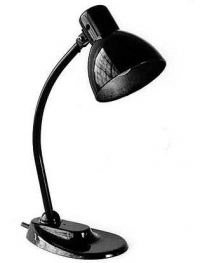Kamden Writing Table Lamp
This lamp produced by the Leipzig firm of Körting & Matthieson, was designed by Hin Bredendieck, a student at the Bauhaus. The Bauhaus (Das Staatliches Bauhaus) was established in Weimar, Germany in 1919 by architect Walter Gropius (1883-1969). The school was moved to Dessau in 1925, and re-named the Institute of Design (Hochschule fur Gestaltung). Gropius resigned in 1928, appointing Hannes Meyer (1889-1954) as his successor. Meyer was replaced by Ludwig Mies van der Rohe (1886-1969) in 1930. In 1932, the Bauhaus was dissolved by the Dessau City Council, and van der Rohe moved the school to Berlin, where it was closed in 1933 by the Nazi Party under Adolph Hitler, thus insuring its martyrdom in the design world. Hin Bredendieck (1904-1995) was born in Aurich, Germany. He enrolled as Bauhaus student in Dessau in 1927, graduating in 1930. He began his practice with Laslo Moholy-Nagy (1895-1946) and Herbert Bayer (1900-1985) in Germany. In 1937 he was invited to the US by Moholy-Nagy to join the Bauhaus in Chicago, and in 1952 became the first director of the design program at the Georgia Institute of Technology, a position he held until his retirement in 1971. He was a participative and outspoken member of IDSA, and received its honored Education Award in 1994. The Kandem Lamp was one of a number of lamps designed at the Bauhaus and produced by Körting & Matthieson. Another similar but shorter table lamp was designed in 1928 by instructor Marianne Brandt (1893-1983), a former student who briefly headed the metal workshops started by Moholy-Nagy 1923, upon his departure in 1928. The Kandem lamps are noteworthy because they are among the few actual Bauhaus product designs produced in quantity, thus fulfilling Walter Gropius' originally stated purpose of products "at a reasonable price through the utilization of all the modern economical means of standardization and wide marketing." Other Bauhaus-designed products produced included pottery and weavings.
